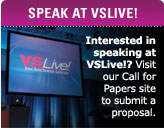Get Your Black Belt at VSLive! 
This four-day virtual track crosses through the most sophisticated, advanced issues you’ll face in today’s—and tomorrow’s—workplace.
All Black Belt sessions in this virtual track are yours when you hold a Gold Passport.
 Get the in-depth, inside scoop on how Smart Client, ASP.NET and Middleware technologies really work. For Intermediate-Advanced developers only, you'll learn advanced tips, tricks and techniques in our Black Belt track.
Get the in-depth, inside scoop on how Smart Client, ASP.NET and Middleware technologies really work. For Intermediate-Advanced developers only, you'll learn advanced tips, tricks and techniques in our Black Belt track.
Richard Hale Shaw, Black Belt Editorial Chair
Jump to the sessions and workshops that interest you most.
SESSIONS
Five Management Essentials with VSTS
Best Practices for Creating ReUsable Managed Code Libraries
Advanced Object Binding Techniques
Requirements Patterns with VSTS
Best Practices for Testing and Debugging Managed Code: VS 2005 & VSTS
Implementing .NET Object Mapping with N Hibernate
Best Kept Secrets in VS 2005 and .NET
Leveraging .NET 2.0 Security Features
Avalon: Vector Graphics Come Alive
WORKSHOPS
VSTS for Everyone:
Best Practices for the Whole Team
Advanced C#:
Patterns and Practices in .NET Framework 2.0
Increase Your Predictability of Success with Team System
Five Management Essentials:
Estimating, Scheduling, Planning, Tracking and Correction with VSTS
Martin Shoemaker, Richard Hale Shaw Group
Does your project use VB.NET or C#? Chances are, your customers don’t know and don’t care. Will your project be on time or late? Now that they care about! How much will it cost? When will it be done? These questions can be more trouble than the technology or languages you use; and they can also be the most important questions for your executives and your customers. This session will show team leads and team members how VSTS helps them in the three key resource management activities: estimating time and costs; planning and scheduling the effort; and tracking, reporting, and correcting as the project runs. Along the way, we’ll discuss some basic estimating, scheduling, and planning techniques.
Best Practices for Creating ReUsable Managed Code Libraries
Richard Hale Shaw, Richard Hale Shaw Group
How do you design good quality APIs and class libraries to run on the .NET Framework? Which type design principles are sound and which aren't? When should an operation be encapsulated as a method vs. a property, and when should it be virtual? How do you design for security and where do performance issues fit in? How should common Framework Patterns be implemented? Which interfaces should be implemented and collection types exposed and which should not? Which naming conventions work and why? In this session, we’ll explore the nature of good class library design. Find out how you can best leverage these ideas in your own libraries, errors to beware of, and how you can establish criteria for conventions your entire team can follow.
Advanced Object Binding Techniques
Deborah Kurata, InStep Technologies
Object binding binds to your code allowing you more control over how your Windows Forms user interface binds to your business objects. But with that control comes responsibility. You are then responsible for handling validation in your business objects and for cleanly reporting errors to the user interface. This session covers how to develop a standard Validation class, perform the validation in your business objects, and build a base business object class to manage the validation and display of data entry errors.
Requirements Patterns with VSTS
Martin Shoemaker, Richard Hale Shaw Group
Some projects use VB .NET, while others use C#, Managed C++, or may be a mix. Some projects are Web-based, while others ran on a desktop or in a console. But no matter how they may differ, all projects are the same in one regard: they all have requirements. And so requirements definition and management should be at the core of any good process. In this session, we'll learn how VSTS helps you to define, store, track, and report requirements. And we'll also learn some simple yet powerful requirements patterns that you can apply to most projects and processes.
Best Practices for Testing and Debugging Managed Code: VS 2005 & VSTS
Richard Hale Shaw, Richard Hale Shaw Group
Testing and debugging aren't programming per se: they're separate, but complimentary skills that every programmer should grow, but often don't. Where programming entails actively asserting your will on the software, testing simply specifies what the result of an operation should be, and that without that result, the test fails. Debugging is neither: it focuses us on what is-not on what should be. Knowing how to effectively develop and apply these skills is critical to every software developer's future. Fortunately, Visual Studio 2005 has a plethora of new debugging features that make Debugging simpler, more straight-forward, and even elegant. And Visual Studio Team System Dev Edition now features built-in Unit Testing system for defining Unit tests before you start programming, and re-run your tests whenever you wish. In this session, Richard will show you how to leverage the maximum results when testing and debugging Managed Code.
Implementing .NET Object Mapping with N Hibernate
Benjamin Day, Benjamin Day Consulting
The problem: our applications use objects, but our databases don’t. Why isn’t there an easy way for applications to use objects, but store their contents in a database with a minimum of effort required to transition between them? Enter N Hibernate: an open-source, object-relational persistence framework that uses XML to map classes and properties (in your program) to tables and columns (in your database). Once you write the mappings, N Hibernate can generate the database code and SQL necessary to save and retrieve your objects. In this session, we’ll take a look at the fundamentals of using N Hibernate in an ASP.NET Web application, with applicability towards any scenario where objects should be transparently persisted.
Best Kept Secrets in VS 2005 and .NET
Deborah Kurata, InStep Technologies
There are many new features in VS 2005, some of which have gotten great publicity (like generics) while others have been left lurking in the shadows. This session will shed some light on these lesser-known features to help you make the most of .NET 2.0. Did you know you could set Application-level events? That there is now a true global error handler? There is better way to manage connection strings? That you can now automatically retain user's settings? This session will cover these topics and much, much more.
Leveraging .NET 2.0 Security Features
Robert Hurlbut, Hurlbut Consulting
Security is difficult to get right, and it is a good strategy to leverage code provided by the upcoming changes in .NET 2.0. The new security components in .NET 2.0 can help you greatly reduce the amount of code you need to write in order to make your applications secure. .NET 2.0 provides numerous additional types that encapsulate functionality already provided in the base Windows OS, as well as new functionality only available in .NET 2.0. This talk will cover the new improvements including public key cryptography, Windows security, remoting, SecureString, XML Encryption, ASP.NET and Code Access Security.
Avalon: Vector Graphics Come Alive
Walt Ritscher, Scandiasoft
The next version of Windows (Windows Vista) will include a completely new graphics engine. This engine, Windows Presentation Foundation (WPF), will change the way you think about user interfaces. WPF (formerly called Avalon), soon to be retro-fitted onto Windows XP and Windows 2003, is a major shift in Windows graphics platform. Built, in part, on a new vector API, WPF blends traditional two-dimensional and three-dimensional systems, transparencies, animation, integrated multi-media and more in a single unified managed code model. Join me to see how WPF is controlled through XAML (Extensible Application Markup Language) or via code. See how incredibly easy it is to create three dimensional applications (including controlling lights, camera and sprites). Examine the significant advances in color, printing, remoting, and audio processing that are included. Immense changes are coming. Be among the first to see what the WPF engine can do.
WORKSHOP
VSTS for Everyone: Best Practices for the Whole Team
Martin L. Shoemaker & Richard Hale Shaw, Richard Hale Shaw Group
With the release of Visual Studio Team System, Visual Studio isn't just for developers any more. It's now a power tool that integrates with MS Office and other tools to support the work of all participants in the development process. In this tutorial, we'll look at each major role in the development process, and we'll see what tools are used in each role, how those tools integrate with VSTS, and how the role is carried out. And then we'll see how the workflow capabilities in VSTS tie all of these roles together into a larger process. And finally, we'll see how to customize the process and the tools to fit your project and your team.
WORKSHOP
Advanced C#: Patterns and Practices in .NET Framework 2.0
Richard Hale Shaw, Richard Hale Shaw Group
The arrival of .NET Framework 2.0 brings with it a whole host of best practices and patterns you should utilize and take advantage of: what classes and members have been made obsolete or deprecated in favor of newer, more powerful ones in .NET 2.0? Which practices and patterns have now been obviated by more elegant solutions found in C# 2.0 and VS2005? How can you best leverage new C# 2.0 features like Generics, Iterators and Nullable Types? And how does Enterprise Library change as .NET absorbs features that originated in the former? In this full-day tutorial, we'll dig into and get answers to these questions, all while using VS2005 to build live code examples.
Pre-requisites: you must already have 1 year of C# development experience with VS.NET 2003 and .NET Framework 1.x: no hand-holding if you don't. While .NET 2.0/C# 2.0 experience is not required, you may find it useful to bring a laptop with VS2005 pre-installed.
WORKSHOP
Increase Your Predictability of Success with Team System
Brian Randell, MCW Technologies
Creating good software solutions is hard. From design, to code cutting, testing, deployment and project management, a software project’s success requires effective team communication and tools the help, not hinder your process. In this workshop, you’ll learn how Visual Studio Team System can help you increase the predictability of success of your software projects. In this workshop you’ll quickly learn what Team System is all about—what you need to run it and what’s included “in-the-box”. Moving forward, you’ll dive deep and learn how to use the various components—SOA designers, Unit Testing, Work Item Tracking, enterprise source code control and Office integration--to build a software solution. You’ll also learn about security, process methodology templates, reporting and very important to most shops—how to customize Team System to work the way you work. At the end of the workshop, you’ll be ready to start your own projects with Team System.




